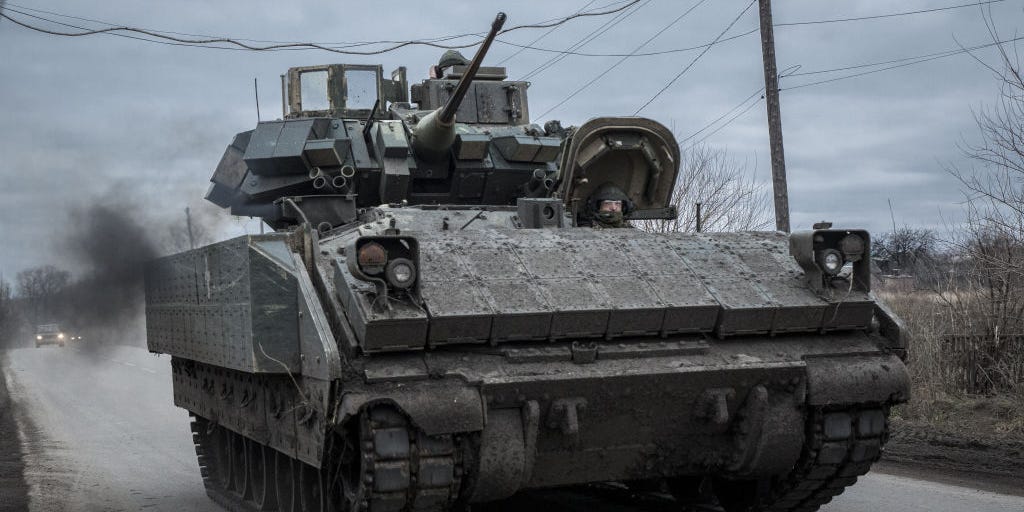The impressive performance of the US-supplied Bradley infantry fighting vehicles in Ukraine's fight against Russia highlights the importance of providing sufficient weaponry to the embattled nation, according to a warfare expert.
Col. Hamish de Bretton-Gordon, a former commander of the UK's Joint Chemical, Biological, Radiological and Nuclear Regiment, told Business Insider that the sheer number of Bradleys, exceeding 300, has been a key factor in their effectiveness compared to other armoured vehicles like Abrams tanks, of which only 31 have been delivered.
"They've got a lot of them," said de Bretton-Gordon, "and if they had a lot of Abrams and a lot of Challengers, they would use them differently."
This observation comes amidst widespread criticism of the West's approach to supplying Ukraine with arms, often in small quantities and with significant delays.
De Bretton-Gordon argues that possessing a substantial number of weapons is essential for any military, allowing for greater flexibility and risk-taking. "When you've only got 14 Challenger 2s, you can't really afford to lose many," he explained. "So I think that is key."
This highlights a shift in Western military thinking. Previously, the focus was on acquiring fewer, more advanced weapons systems. However, de Bretton-Gordon believes a balance is needed, acknowledging that quantity matters.
The Bradley, a vehicle initially designed to counter Soviet infantry fighting vehicles, entered service in the 1980s. While not the most advanced armoured vehicle, its versatility and capability have earned it a "Bradley legend" status in Ukraine, according to de Bretton-Gordon.
"So when you look at the Bradleys, it's their mass and the way that they're used, which is why they're so successful," he explained. The vehicles have been deployed in various roles, from engaging infantry in fortified positions to confronting troop carriers, drones, and even tanks.
De Bretton-Gordon emphasizes the psychological impact of the Bradleys, stating, "It stiffens the resolve of the Ukrainians, and no doubt it's also added fear to the Russians."
The slow and piecemeal delivery of weapons to Ukraine has been a source of frustration for many experts, soldiers, and even some allied governments. This "drip feeding" of equipment, as de Bretton-Gordon described it, has hampered Ukraine's ability to fight at its full potential.
An American soldier fighting in Ukraine told BI earlier this year that Western aid often arrived too late and in insufficient amounts. "It feels like whenever they donate things, it's kind of just enough to keep Ukraine standing but without thought of the long term," he said, highlighting the lack of long-term strategy and planning.
De Bretton-Gordon echoes this sentiment, arguing that providing a larger number of tanks early on would have significantly impacted the war. "Had we not waited a year and given them tanks straight away, and had we given them hundreds of tanks, not a hundred, of course, it would make a huge difference," he said.
Despite the limited number of Abrams tanks supplied, the Bradley's success in Ukraine has proven its value. Experts have noted the vehicle's agility and adaptability to the war's specific challenges.
Nicholas Drummond, a former British Army officer and land-warfare analyst, believes the Bradley's effectiveness stems from its lighter frame, allowing it to navigate terrain inaccessible to heavier tanks. Its flexible cannon with a high rate of fire provides fire support and can disable enemy tanks' sensors.
De Bretton-Gordon described the Bradley as "a really good piece of kit because it's reliable, it's easy to use, it moves around quickly, and it is fairly well protected."
The vehicle's performance in Ukraine has led to a reassessment of its capabilities. "They're creating a bit of a legend," de Bretton-Gordon acknowledged, noting that the Bradley's reputation has improved significantly since the war began.
Ukraine's success in utilising Bradleys against Russian tanks, particularly against some of Russia's most advanced models like the T-90 and T-80, highlights their ability to exploit vulnerabilities in Russian armour.
De Bretton-Gordon pointed out the weaknesses in the design of these Russian tanks, specifically the junction between the turret and hull, which lacks sufficient armour. This vulnerability allows even smaller rounds fired from the Bradley to inflict significant damage.
The sheer number of Bradleys available has allowed Ukraine to employ them effectively in aggressive tactics, including ambushes.
"And, of course, if you've got two or three Bradleys firing at one T-90 â and the Russians haven't been very clever, the way they've used their tanks â that overwhelming firepower means that they're taking these T-90s out and the Bradley is sort of becoming a bit of a mythological beast," de Bretton-Gordon concluded.
The success of the Bradley in Ukraine serves as a powerful reminder that quantity, alongside quality, plays a vital role in modern warfare. It also underscores the significance of providing adequate and timely support to allies facing aggression, enabling them to fight effectively and decisively.
Article
Business

Ukraine's Bradley Triumph: A Lesson in Quantity and Resolve

